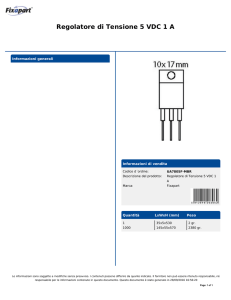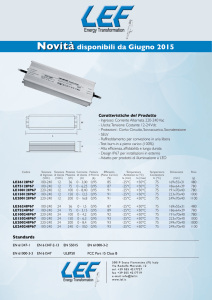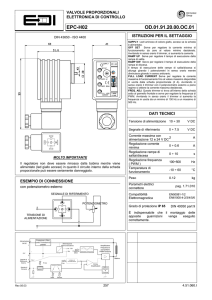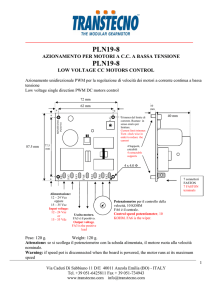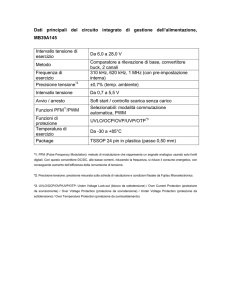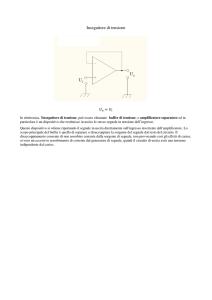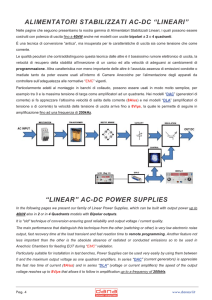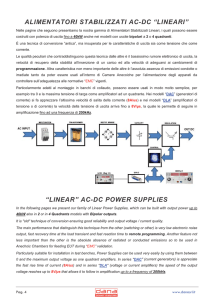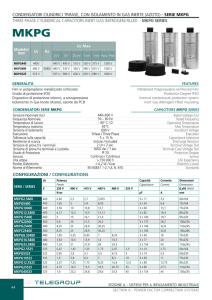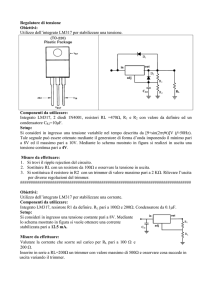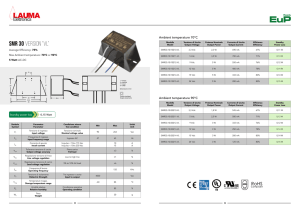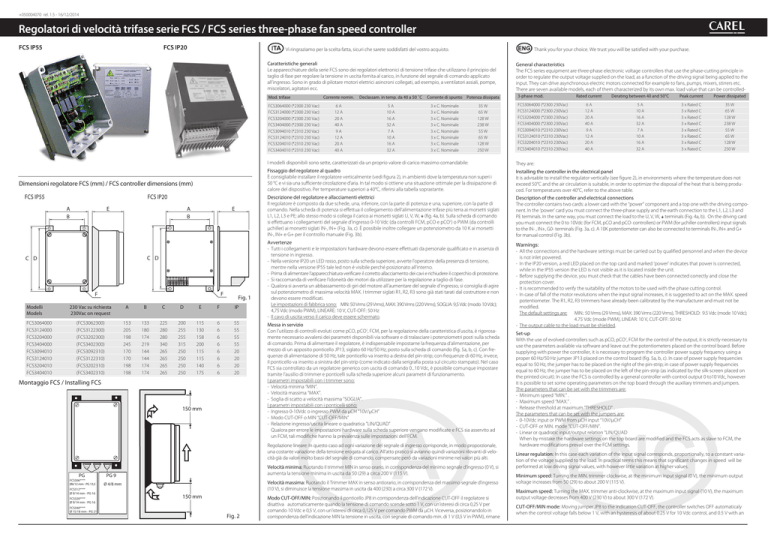
+050004070 rel. 1.5 - 16/12/2014
Regolatori di velocità trifase serie FCS / FCS series three-phase fan speed controller
FCS IP55
FCS IP20
Vi ringraziamo per la scelta fatta, sicuri che sarete soddisfatti del vostro acquisto.
Thank you for your choice. We trust you will be satisfied with your purchase.
Caratteristiche generali
Le apparecchiature della serie FCS sono dei regolatori elettronici di tensione trifase che utilizzano il principio del
taglio di fase per regolare la tensione in uscita fornita al carico, in funzione del segnale di comando applicato
all’ingresso. Sono in grado di pilotare motori elettrici asincroni collegati, ad esempio, a ventilatori assiali, pompe,
miscelatori, agitatori ecc.
Mod. trifase
FCS3064000 (*2300 230 Vac)
FCS3124000 (*2300 230 Vac)
FCS3204000 (*2300 230 Vac)
FCS3404000 (*2300 230 Vac)
FCS3094010 (*2310 230 Vac)
FCS3124010 (*2310 230 Vac)
FCS3204010 (*2310 230 Vac)
FCS3404010 (*2310 230 Vac)
Dimensioni regolatore FCS (mm) / FCS controller dimensions (mm)
FCS IP55
FCS IP20
A
B
E
A
B
E
C D
C D
F
F
Modelli
Models
FCS3064000
FCS3124000
FCS3204000
FCS3404000
FCS3094010
FCS3124010
FCS3204010
FCS3404010
Fig. 1
230 Vac su richiesta
230Vac on request
A
B
C
D
E
F
IP
(FCS3062300)
(FCS3122300)
(FCS3202300)
(FCS3402300)
(FCS3092310)
(FCS3122310)
(FCS3202310)
(FCS3402310)
153
205
198
245
170
170
198
198
133
180
174
219
144
144
174
174
225
280
280
340
265
265
265
265
200
255
255
315
250
250
250
250
115
130
158
200
115
115
140
175
6
6
6
6
6
6
6
6
55
55
55
55
20
20
20
20
Montaggio FCS / Installing FCS
150 mm
Corrente nomin.
Declassam. in temp. da 40 a 50 ˚C
6A
12 A
20 A
40 A
9A
12 A
20 A
40 A
5A
10 A
16 A
32 A
7A
10 A
16 A
32 A
Corrente di spunto Potenza dissipata
3 x C. Nominale
3 x C. Nominale
3 x C. Nominale
3 x C. Nominale
3 x C. Nominale
3 x C. Nominale
3 x C. Nominale
3 x C. Nominale
35 W
65 W
128 W
238 W
55 W
65 W
128 W
250 W
PG
FCS312****
Ø 9/14 mm - PG 16
FCS320****
Ø 9/14 mm - PG 16
PG 9
FCS340****
Ø 15/18 mm - PG 21
Fig. 2
Derating between 40 and 50°C
Peak current
Power dissipated
6A
12 A
20 A
40 A
9A
12 A
20 A
40 A
5A
10 A
16 A
32 A
7A
10 A
16 A
32 A
3 x Rated C
3 x Rated C
3 x Rated C
3 x Rated C
3 x Rated C
3 x Rated C
3 x Rated C
3 x Rated C
35 W
65 W
128 W
238 W
55 W
65 W
128 W
250 W
They are:
Installing the controller in the electrical panel
It is advisable to install the regulator vertically (see figure 2), in environments where the temperature does not
exceed 50°C and the air circulation is suitable, in order to optimize the disposal of the heat that is being produced. For temperatures over 40°C, refer to the above table.
Descrizione del regolatore e allacciamenti elettrici
Il regolatore è composto da due schede, una, inferiore, con la parte di potenza e una, superiore, con la parte di
comando. Nella scheda di potenza si effettua il collegamento dell’alimentazione trifase più terra ai morsetti siglati
L1, L2, L3 e PE; allo stesso modo si collega il carico ai morsetti siglati U, V, W, (fig. 4a, b). Sulla scheda di comando
si effettuano i collegamenti del segnale d’ingresso 0-10 Vdc (da controlli FCM, pCO e pCO2) o PWM (da controlli
μchiller) ai morsetti siglati IN-, IN+ (Fig. 3a, c). È possibile inoltre collegare un potenziometro da 10 K ai morsetti
IN-, IN+ e G+ per il controllo manuale (Fig. 3b).
Description of the controller and electrical connections
The controller contains two cards: a lower card with the “power” component and a top one with the driving component. In the ‘power’ card you must connect the three-phase supply and the earth connection to the L1, L2, L3 and
PE terminals. In the same way, you must connect the load to the U, V, W, terminals (Fig. 4a, b). On the driving card
you must connect the 0 to 10Vdc (for FCM, pCO and pCO controllers) or PWM (for μchiller controllers) input signals
to the IN- , IN+, G0- terminals (Fig. 3a, c). A 10K potentiometer can also be connected to terminals IN-, IN+ and G+
for manual control (Fig. 3b).
Avvertenze
- Tutti i collegamenti e le impostazioni hardware devono essere effettuati da personale qualificato e in assenza di
tensione in ingresso.
- Nella versione IP20 un LED rosso, posto sulla scheda superiore, avverte l’operatore della presenza di tensione,
mentre nella versione IP55 tale led non é visibile perché posizionato all’interno.
- Prima di alimentare l’apparecchiatura verificare il corretto allacciamento dei cavi e richiudere il coperchio di protezione.
- Si raccomanda di verificare l’idoneità dei motori da utilizzare per la regolazione a taglio di fase.
- Qualora si avverta un abbassamento di giri del motore all’aumentare del segnale d’ingresso, si consiglia di agire
sul potenziometro di massima velocità MAX. I trimmer siglati R1, R2, R3 sono già stati tarati dal costruttore e non
devono essere modificati.
Le impostazioni di fabbrica sono: MIN: 50 Vrms (29 Vrms), MAX: 390 Vrms (220 Vrms), SOGLIA: 9,5 Vdc (modo 10 Vdc);
4,75 Vdc (modo PWM), LINEARE: 10 V, CUT-OFF: 50 Hz
- Il cavo di uscita verso il carico deve essere schermato.
Warnings:
Messa in servizio
Con l’utilizzo di controlli evoluti come pCO, pCO2, FCM, per la regolazione della caratteristica d’uscita, è rigorosamente necessario avvalersi dei parametri disponibili via software e di tralasciare i potenziometri posti sulla scheda
di comando. Prima di alimentare il regolatore, è indispensabile impostarne la frequenza d’alimentazione, per
mezzo di un apposito ponticello JP13, siglato 60 Hz/50 Hz, posto sulla scheda di comando (fig. 5a, b, c). Con frequenze di alimentazione di 50 Hz, tale ponticello va inserito a destra del pin-strip; con frequenze di 60 Hz, invece,
il ponticello va inserito a sinistra del pin-strip (come indicato dalla serigrafia posta sul circuito stampato). Nel caso
FCS sia controllato da un regolatore generico con uscita di comando 0...10 Vdc, è possibile comunque impostare
tramite l’ausilio di trimmer e ponticelli sulla scheda superiore alcuni parametri di funzionamento.
I parametri impostabili con i trimmer sono:
- Velocità minima “MIN”.
- Velocità massima “MAX”.
- Soglia di scatto a velocità massima “SOGLIA”.
I parametri impostabili con i ponticelli sono:
- Ingresso 0-10Vdc o ingresso PWM da μCH “10V/μCH”
- Modo CUT-OFF o MIN “CUT-OFF/MIN”
- Relazione ingresso/uscita lineare o quadratica “LIN/QUAD”
Qualora per errore le impostazioni hardware sulla scheda superiore vengano modificate e FCS sia asservito ad
un FCM, tali modifiche hanno la prevalenza sulle impostazioni dell’FCM.
Velocità massima: Ruotando il Trimmer MAX in senso antiorario, in corrispondenza del massimo segnale d’ingresso
(10 V), si diminuisce la tensione massima in uscita da 400 (230) a circa 300 V (172 V).
150 mm
FCS3064000 (*2300 230Vac)
FCS3124000 (*2300 230Vac)
FCS3204000 (*2300 230Vac)
FCS3404000 (*2300 230Vac)
FCS3094010 (*2310 230Vac)
FCS3124010 (*2310 230Vac)
FCS3204010 (*2310 230Vac)
FCS3404010 (*2310 230Vac)
Rated current
Fissaggio del regolatore al quadro
È consigliabile installare il regolatore verticalmente (vedi figura 2), in ambienti dove la temperatura non superi i
50 °C e vi sia una sufficiente circolazione d’aria. In tal modo si ottiene una situazione ottimale per la dissipazione di
calore del dispositivo. Per temperature superiori a 40°C, riferirsi alla tabella soprastante.
Velocità minima: Ruotando il trimmer MIN in senso orario, in corrispondenza del minimo segnale d’ingresso (0 V), si
aumenta la tensione minima in uscita da 50 (29) a circa 200 V (115 V).
Ø 4/8 mm
3-phase mod.
I modelli disponibili sono sette, caratterizzati da un proprio valore di carico massimo comandabile:
Regolazione lineare: In questo caso ad ogni variazione del segnale di ingresso corrisponde, in modo proporzionale,
una costante variazione della tensione erogata al carico. All’atto pratico si avranno quindi variazioni rilevanti di velocità già da valori molto bassi del segnale di comando, compensate però da variazioni minime nei valori più alti.
FCS306****
Ø6/12 mm - PG 13,5
General characteristics
The FCS series equipment are three-phase electronic voltage controllers that use the phase-cutting principle in
order to regulate the output voltage supplied on the load, as a function of the driving signal being applied to the
input. They can drive asynchronous electric motors connected for example to fans, pumps, mixers, stirrers etc.
There are seven available models, each of them characterized by its own max. load value that can be controlled-
Modo CUT-OFF/MIN: Posizionando il ponticello JP8 in corrispondenza dell’indicazione CUT-OFF il regolatore si
disattiva automaticamente quando la tensione di comando scende sotto 1 V, con un’isteresi di circa 0,25 V per
comando 10 Vdc e 0,5 V, con un’isteresi di circa 0,125 V per comando PWM da μCH. Viceversa, posizionandolo in
corrispondenza dell’indicazione MIN la tensione in uscita, con segnale di comando min. di 1 V (0,5 V in PWM), rimane
2
- All the connections and the hardware settings must be carried out by qualified personnel and when the device
is not inlet powered.
- In the IP20 version, a red LED placed on the top card and marked ‘power’ indicates that power is connected,
while in the IP55 version the LED is not visible as it is located inside the unit.
- Before supplying the device, you must check that the cables have been connected correctly and close the
protection cover.
- It is recommended to verify the suitability of the motors to be used with the phase cutting control.
- In case of fall of the motor revolutions when the input signal increases, it is suggested to act on the MAX. speed
potentiometer. The R1, R2, R3 trimmers have already been calibrated by the manufacturer and must not be
modified.
The default settings are: MIN.: 50 Vrms (29 Vrms), MAX: 390 Vrms (220 Vrms), THRESHOLD: 9.5 Vdc (mode 10 Vdc);
4.75 Vdc (mode PWM), LINEAR: 10 V, CUT-OFF: 50 Hz
- The output cable to the load must be shielded.
Set-up
With the use of evolved controllers such as pCO, pCO2, FCM for the control of the output, it is strictly necessary to
use the parameters available via software and leave out the potentiometers placed on the control board. Before
supplying with power the controller, it is necessary to program the controller power supply frequency using a
proper 60 Hz/50 Hz jumper JP13 placed on the control board (fig. 5a, b, c). In case of power supply frequencies
equal to 50 Hz, the jumper has to be placed on the right of the pin-strip; in case of power supply frequencies
equal to 60 Hz, the jumper has to be placed on the left of the pin-strip (as indicated by the silk-screen placed on
the printed circuit). In case the FCS is controlled by a general controller with control output 0 to10 Vdc, however
it is possible to set some operating parameters on the top board through the auxiliary trimmers and jumpers.
The parameters that can be set with the trimmers are:
- Minimum speed “MIN.” .
- Maximum speed “MAX.” .
- Release threshold at maximum “THRESHOLD” .
The parameters that can be set with the jumpers are:
- 0-10Vdc input or PWM from μCH input “10V/μCH”
- CUT-OFF or MIN. mode “CUT-OFF/MIN”.
- Linear or quadratic input/output relation “LIN/QUAD
When by mistake the hardware settings on the top board are modified and the FCS acts as slave to FCM, the
hardware modifications prevail over the FCM settings.
Linear regulation: In this case each variation of the input signal corresponds, proportionally, to a constant variation of the voltage supplied to the load. In practical terms this means that significant changes in speed will be
performed at low driving signal values, with however little variation at higher values.
Minimum speed: Turning the MIN. trimmer clockwise, at the minimum input signal (0 V), the minimum output
voltage increases from 50 (29) to about 200 V (115 V).
Maximum speed: Turning the MAX. trimmer anti-clockwise, at the maximum input signal (10 V), the maximum
output voltage decreases from 400 V (230 V) to about 300 V (172 V).
CUT-OFF/MIN mode: Moving jumper JP8 to the indication CUT-OFF, the controller switches OFF automaticaly
when the control voltage falls below 1 V, with an hysteresis of about 0.25 V for 10 Vdc control, and 0.5 V with an
Collegamento al modulo di comando FCM / Connection to FCM driving module
IN-
Potenziometro
Potentiometer
G+
SOGLIA: Ruotando il trimmer SOGLIA in senso antiorario si diminuisce il valore della tensione di comando (da 7 a
10 V con comando 0-10 Vdc o da 3,5 a 5 V con comando PWM) al di sopra della quale la tensione in uscita si porta
istantaneamente al valore massimo, altrimenti ruotare il trimmer in senso orario.
10 K
IN+
Fig. 3a
al valore impostato tramite il trimmer MIN.
Modo 10V/μCH: Posizionando il ponticello JP7 in corrispondenza dell’indicazione 10 V, il segnale di comando deve
avere un’estensione da 0 a 10 Vdc. Viceversa, posizionandolo in corrispondenza dell’indicazione μCH il segnale di
comando PWM deve avere un’estensione di 5 V.
Fig. 3b
hysteresis of about 0.125 V for PWM control from μCH. Vice-versa, moving it to the indication MIN, the output voltage, with a min. control voltage of 1V (0.5 V for PWM), remains at the value set using the MIN trimmer.
10 V/μCH mode: Moving jumper JP7 to the indication 10 V, the control signal must have a range from 0 to 10 Vdc.
Vice-versa, moving it to the indication μCH, the PWM control signal must have a range of 5 V.
THRESHOLD: Turning the THRESHOLD trimmer anti-clockwise, the value of the control voltage decreases (from
7 to 10 V with 0...10 Vdc control, or from 3.5 to 5 V with PWM control), above which the output voltage instantaneously goes to the maximum value; to avoid this, turn the trimmer clockwise.
Di seguito viene rappresentata graficamente la situazione appena descritta, nelle modalità MIN, MAX e CUT-OFF.
Following, you will find a graph representation of the above-described situation, in MIN, MAX and CUT-OFF modes.
trimmer MIN / MIN trimmer
400V
(230V)
0V
0%
Collegamento di potenza / Connection to load
U V W
INPUT
OUTPUT
Alimentazione trifase
Three-phase supply
Portata/Rate = 1,1 In
M3
Fig. 4b
trimmer SOGLIA / THRESHOLD trimmer
Tensione uscita
Output voltage
Fig. 4a
Segnale ingresso
Input signal
Tensione uscita
Output voltage
7,5% 10%
min
...100%
Segnale ingresso
Input signal
100%
0V
Scheda di comando FCS 6 A
6A Master Board FCS
modo LIN/QUAD / LIN/QUAD mode
400V
(230V)
modo CUT-OFFMIN,
/ CUT
-OFF
mode
esempio/example:
MAX
& CUT-OFF
400V
(230V)
400V
(230V)
POWER
SUPPLY
max
350V
(200V)
min
300V
(172V)
0V
Segnale ingresso
Input signal
100%
Segnale ingresso
Input signal
Fig. 5a
R1
R2
R3
INPUT
JP6
MIN
MAX
JP9
60Hz/50Hz
JP5
LIN/QUAD
JP7
I/V
JP8
10V/ûAC
CUT-OFF/MIN
0%
SOGLIA
JP13
IN+ IN- G+
Scheda di comando FCS 9-12-20-40 A IP55 e 20-40 A IP20/ 9-12-20-40A IP55 and 20-40A IP20 Master Board FCS
R1
POWER
SUPPLY
R2
R3
LIN/QUAD
MIN
MAX
SOGLIA
10V/AC
JP9
CUT-OFF/MIN
Fig. 5b
INPUT
JP7
JP8
JP5
60Hz/50Hz
JP13
I/V
IN+ IN- G+
JP6
Scheda di comando FCS 12 A IP20
12A IP20 Master Board FCS
R1
R2
R3
POWER
SUPPLY
MIN
MAX
SOGLIA
LIN/QUAD
JP9
CUT-OFF/MIN
Fig. 5c
JP8
10V/AC
JP7
60Hz/50Hz
JP13
INPUT
JP5
I/V
JP6
CAREL INDUSTRIES HQs
Via dell’Industria, 11 - 35020 Brugine - Padova (Italy)
Tel. (+39) 0499716611 – Fax (+39) 0499716600
http://www.carel.com – e-mail: [email protected]
IN+ IN- G+
0V
70%
100%
Segnale ingresso
Input signal
THRESHOLD
0%
trimmer SOGLIA / THRESHOLD trimmer
400V
(230V)
modo LIN/QUAD / LIN/QUAD mode
Caratteristiche tecniche
Alimentazione trifase
Frequenza
Segnale di comando (selezionabile da ponticello)
Tensione di segnale di comando G+
Corrente segnale di comando
Inpedenza d’ingresso (circuito di comando)
Potenza assorbita (circuito di comando)
Temperatura di lavoro
Temperatura di immagazzinamento
Temperatura max dissipatore
Caratteristiche di invecchiamento
Tipo di azione-disconnessione
Grado di polluzione del regolatore
Grado di protezione involucro
Periodo di sollecitazioni elettriche delle parti isolanti
Classificazione secondo la protez. contro le scosse elettriche
100%
0% 10%
...100%
modo CUT-OFFMIN,
/ CUT
-OFF
mode
esempio/example:
MAX
& CUT-OFF
400V
(230V)
400V
(230V)
100V
(57V)
max
350V
(200V)
100V
(57V)
min
0V
Segnale ingresso
Input signal
7,5% 10%
Segnale ingresso
Input signal
100%
min
0V
0V
0%
0%
LIN/QUAD mode: If jumper JP9 is moved to the indication QUAD, the relationship between the variation of the
input signal and the voltage supplied to the load is quadratic-type. In practical terms, this achieves a “softer”
start-up of the load and significant variations in speed at the higher input signal values, meaning faster and faster
responses near to the upper limits of the control band. Vice-versa, if moved to the indication LIN, there will be a
linear proportional relationship between the control signal and the voltage supplied to the load, with slight variations in speed corresponding to significant changes in the control signal near the end scale.
Following you will find a graphic representation of the above-described situation, in THRESHOLD and LIN/QUAD
modes and an example of a combination.
Tensione uscita
Output voltage
L1 L2 L3
In=corrente nominale motore
Motor nominal current
M3
0V
Modo LIN/QUAD: Nel caso il ponticello JP9 sia posizionato in corrispondenza dell’indicazione QUAD, la relazione
tra variazione del segnale di comando e tensione erogata al carico é di tipo quadratica. All’atto pratico si ottiene
una partenza più “dolce” del carico e delle variazioni rilevanti di velocità nei valori più alti del segnale di ingresso,
offrendo risposte sempre più rapide all’avvicinarsi del limite superiore della banda di regolazione. Viceversa, nel
caso sia posizionato in corrispondenza dell’indicazione LIN si ottiene una proporzionalità diretta lineare tra il
segnale di comando e la tensione fornita al carico con modeste variazioni di velocità relative a grandi scostamenti del segnale di comando in prossimità del fondo scala.
Di seguito viene rappresentata graficamente la situazione appena descritta, nelle modalità SOGLIA, LIN/QUAD e
un esempio di combinazione.
Tensione uscita
Output voltage
PE
OUTPUT
Alimentazione trifase
Three-phase supply
200V
(115V)
0%
0%
Tensione uscita
Output voltage
mod. 40 A
U V W
100%
max
0%
Magnetotermico di tipo C
Type C magnetothermal protection
PE
Segnale ingresso
Input signal
400V
(230V)
Tensione uscita
Output voltage
0V
400V
(230V)
Tensione uscita
Output voltage
Fig. 3c
modo CUT-OFF / CUT -OFF mode
...max
min
300V
(172V)
Tensione uscita
Output voltage
PWM
min
mod. 6-12-20 A
trimmer MAX / MAX trimmer
max
200V
(115V)
INPUT
trimmer MIN / MIN trimmer
400V
(230V)
Tensione uscita
Output voltage
Tensione uscita
Output voltage
...max
fan
output
L1 L2 L3
modo CUT-OFF / CUT -OFF mode
Tensione uscita
Output voltage
μchiller series
trimmer MAX / MAX trimmer
Tensione uscita
Output voltage
Collegamento ai regolatori della serie μchiller / Connection to μchiller series regulators
0V
Segnale ingresso 100%
Input signal
400 Vac (230 Vac) +10%/-15%
50/60 Hz
0/10 Vdc o PWM per serie μchiller (5Vpp)
18-26 Vdc FCS3xx40xx, 24/33 Vdc FCS3xx23xx
50 mA max
10 KΩ
8 VA
-10T50°C (vedi declassamento in temperatura)
-20T70 °C
75°C
60.000 ore
1C
Normale
IP55 / IP20
Lungo
classe II alla morsettiera degli ingressi 0/10V (isolamento di
4000 V tra segnale d’ingresso a bassissima tensione e
parti in tensione del dispositivo) e classe I rispetto le
parti accessibili.
Tutti i modelli di regolatori sono marcati CE e conformi alle direttive comunitarie 73/23 CEE, 89/336 CEE e aggiornamenti successivi.
I requisiti essenziali delle direttive sono soddisfatti dalla conformità alle norme
NOME
TIPO
REGOLATORI COPERTI DA VERIFICA
• CEI EN 60730-1
Sicurezza
FCS306****, FC309****, FCS312****, FCS320****, FCS340****
• CEI EN 50081-1
Emissione Residenziale
FCS306****, FC309****, FCS312****, FCS320****
• CEI EN 50082-1
Immunità Residenziale
FCS306****, FC309****, FCS312****, FCS320****
• CEI EN 55014-1
Emissione Amb. Dom.
FCS306****, FC309****, FCS312****, FCS320****
• CEI EN 55014-2
Immunità Amb. Dom.
FCS306****, FC309****, FCS312****, FCS320****
• CEI EN 50081-2
Emissione Industriale
FCS340****
• CEI EN 50082-2
Immunità Industriale
FCS340****
Note sulla massima corrente dispersa nel modello da 20 A: corrente dispersa verso terra dal regolatore
- funzionamento normale Id 0,03 mA
- con una fase mancante Id 5,95 mA
- con una sola fase collegata Id 11,3 mA
Note per la prova di tensione applicata
Il dispositivo è provvisto di un filtro EMC interno avente due condensatori verso terra. Nella prova di tensione applicata, tali condensatori possono essere temporaneamente esclusi togliendo il cavo collegato al faston siglato J1. Al termine della prova, il cavo
deve essere ricollegato.
0V
0%
70%
100%
Segnale ingresso
Input signal
THRESHOLD
0%
0V
Segnale ingresso
Input signal
Technical specifications
Three-phase power supply
Frequency
Driving signal (that can be selected by the jumper)
Command signal voltage G+
Control signal voltage
Input impedance (control circuit)
Power consumption (control circuit)
Operating temperature
Storage temperature
Max. heatsink temperature
Ageing specification
Action-disconnection type
Pollution degree of the controller
Index of protection of the case
Period of electric stress across insulating parts
Classification according to protection against electric shocks
100%
0% 10%
Segnale ingresso 100%
Input signal
400 Vac (230 Vac) +10%/-15%
50/60 Hz
0/10 Vdc or PWM for μchiller series (5 Vpp)
18/26 Vdc FCS3xx40xx, 24/33 Vdc FCS3xx23xx
50 mA max
10 KΩ
8 VA
-10T50°C (see temperature derating)
-20T70°C
75°C
60.000 h
1C
Normal
IP55 / IP20
Long
class II at the 0/10 Vdc input terminal block (insulation of
4000 V between the input signal at very low voltage and
the device supplied parts) and class I as regards the
accessible parts.
All the models of the controllers are CE marked and comply with the EEC directives 73/23, 89/336 and successive amendments.
The essential requirements of the directives are satisfied by conformity to the following standards
NAME
TYPE
CONTROLLER COVERED
• CEI EN 60730-1
Safety
FCS306****, FC309****, FCS312****, FCS320****, FCS340****
• CEI EN 50081-1
Residential Emissions
FCS306****, FC309****, FCS312****, FCS320****
• CEI EN 50082-1
Residential Immunity
FCS306****, FC309****, FCS312****, FCS320****
• CEI EN 55014-1
Emissions, Household
FCS306****, FC309****, FCS312****, FCS320****
• CEI EN 55014-2
Immunity, Household
FCS306****, FC309****, FCS312****, FCS320****
• CEI EN 50081-2
Heavy Industrial Emissions
FCS340****
• CEI EN 50082-2
Heavy Industrial Immunity
FCS340****
Notes on the maximum current leakage in the 20 A model: earth leakage current from the controller
- in normal operation Id 0.03 mA
- with one phase missing Id 5.95 mA
- with one phase only connected Id 11.3 mA
Notes on the voltage tests applied
The device is fitted with an internal EMC filter with two capacitors to earth. In the voltage test applied, these capacitors can be
temporarily bypassed, by removing the cable connected to the faston marked J1. At the end of the test, the cable must be connected again.
Carel si riserva la possibilità di apportare modifiche o cambiamenti ai propri prodotti senza alcun preavviso.
Carel reserves the right to alter the features of its products without prior notice.
+050004070 rel. 1.5 - 16/12/2014

